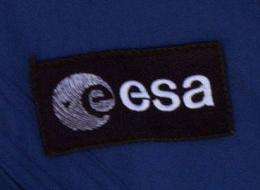Space debris: Europe to set up monitor

The European Space Agency (ESA) hopes to start monitoring orbital debris within the next few years, an official said Thursday at the close of the largest-ever conference on a worsening space peril.
"The goal is to be able to offer 'precursor' services in the next two or three years which among other things issue alerts about collision risks," said Nicolas Bobrinsky of ESA's European Space Operations Centre in Darmstadt.
"We already have the installations and a knowledge base which we have to bring together and use," he told AFP.
The four-day conference, attended by 330 specialists from 21 countries, took place against a backdrop of deepening concern at the accumulation of debris in Earth's backyard.
The rubble -- typically shards of old rocket motors or pieces of old satellites, but also including tools lost in spacewalks -- is often very small.
But it poses a threat to operational satellites and manned missions as it travels at very high speeds and can inflict a devastating impact.
The International Space Station had two debris warnings last month alone. In one incident, its three-member crew had to shelter in a docked Soyuz capsule when a chunk passed by at a distance of some 4.5 kilometers (2.7 miles).
Bobrinsky told AFP that ESA's aim was to expand and deepen its flow of data about space debris.
Satellite operators get their information about debris from the United States, which tracks the threat using ground-based radar and claims an accuracy to within 100 metres (325 feet).
The junk publicly catalogued by the United States is larger than five centimetres (two inches), "but they can probably do much more," said Heiner Klinkrad, ESA's top debris expert, who chaired the Darmstadt conference.
"They can probably track one-centimetre (0.4-inch) objects, which is the shielding limit" for protecting spacecraft against impact, he said.
At present, European capacity is to track debris at least one metre (3.25 feet) in diameter with an accuracy of one kilometre (five-eights of a mile).
Over the past year, tests have been been carried out using three facilities, said Klinkrad -- a radar at Wachtberg, in northwestern Germany; a 100-metre radiotelescope at Effelsberg, western Germany; and a network of radar stations, called Eiscat, in Finland, Norway and Sweden.
"With those facilities, we could detect objects with a diameter of one centimetre (0.4 inches) and we could track (objects of) four centimetres (2.5 inches)," said Klinkrad.
Eventually, he hoped, European facilities will be able to track debris of 10 centimetres (4.5 inches) in low Earth orbit, and one metre or smaller in geostationary orbit.
He stressed, though, that a European monitoring system was still at an embryonic phase. The agency was sounding out commercial customers to see if they would be interested in the scheme.
There are around 600,000 objects larger than one centimetre in orbit, of which more than 13,000 are greater than 10 centimetres (4.5 inches), ESA says.
It can take years, decades -- or even longer -- before the junk, tugged by terrestrial gravity, falls to Earth and is consumed by friction with the atmosphere.
In February, a disused Russian military satellite, Cosmos 2251, collided with a US communications satellite owned by the Iridium company at an altitude of around 800 kilometers (500 miles), creating a further debris cloud.
These clouds themselves generate more debris through further collision.
The worst debris zones are in low Earth orbit (LEO), between 800 and 1,500 kilometres (500 and 950 miles) above the Earth, and in geostationary orbit, about 35,000 kilometres (22,000 miles) up.
The International Space Station is on a trajectory of around 350 kilometres (220 miles) above Earth.
(c) 2009 AFP

















